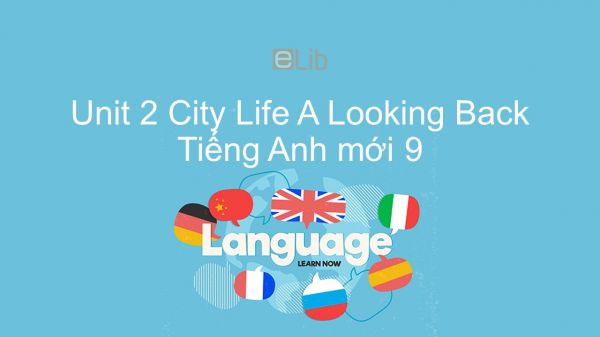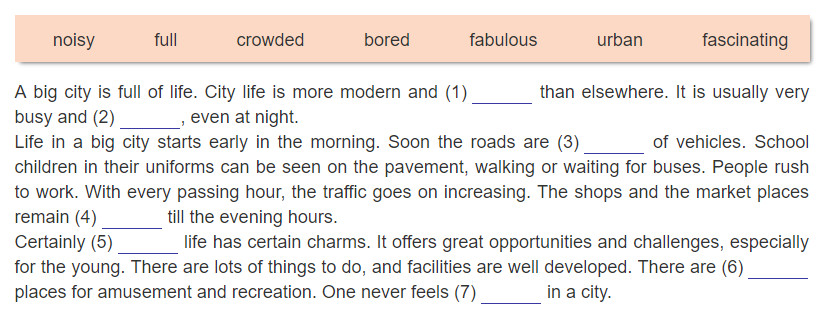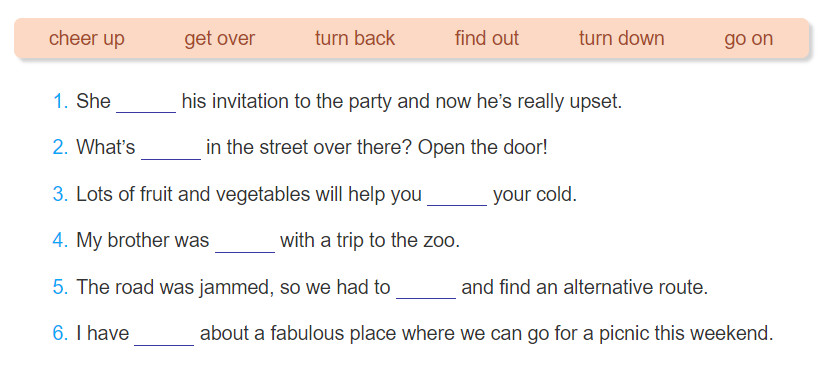Unit 2 lớp 9: City Life - Looking Back
Bài học Unit 2 lớp 9 mới phần Looking Back giúp các em ôn tập lại nội dung từ vựng cũng như ngữ pháp đã học về các thành phố nổi tiếng hay các danh lam thắng cảnh. Mời các em cùng tham khảo!
Mục lục nội dung

Unit 2 lớp 9: City Life - Looking Back
1. Vocabulary
1.1. Task 1 Unit 2 lớp 9
Complete the word webs with nouns and adjectives connected with the city. (Hoàn thành mạng từ với các danh từ và tính từ liên quan tới thành phố.)
Guide to answer
Nouns: skyscraper, dweller, index, asset, metro, traffic jam, urban sprawl, shopping mall, gallery, cinema, recreational facilities.
Adjectives: cosmopolitan, metropolitan, multicultural, urban, downtown, populous, livable, modern, polluted.
1.2. Task 2 Unit 2 lớp 9
Put one word from the box in each gap. (Điền 1 từ trong bảng vào chỗ trống.)

Guide to answer
1. fascinating
2. noisy
3. full
4. crowded
5. urban
6. fabulous
7. bored
Tạm dịch:
Một thành phố lớn luôn năng động, tràn đầy sức sống. Cuộc sống thành phố hiện đại hơn và hấp dẫn hơn những nơi khác. Nó thường rất bận rộn và ồn ào, ngay cả vào ban đêm.
Cuộc sống ở một thành phố lớn bắt đầu từ sáng sớm. Chẳng mấy chốc những con đường đã đầy xe cộ. Học sinh mặc đồng phục có thể được nhìn thấy trên vỉa hè, đi bộ hoặc chờ xe buýt. Mọi người vội vã đi làm. Với mỗi giờ trôi qua, lưu lượng người ngày càng tăng. Các cửa hàng và khu chợ vẫn còn đông đúc đến tận giờ tối.
Chắc chắn cuộc sống thành thị có những nét quyến rũ nhất định. Nó mang đến những cơ hội và thách thức lớn, đặc biệt là cho giới trẻ. Có rất nhiều thứ để làm, và các cơ sở được phát triển tốt. Có những nơi vui chơi giải trí tuyệt vời. Một người không bao giờ cảm thấy buồn chán trong một thành phố.
2. Grammar
2.1. Task 3 Unit 2 lớp 9
Complete each sentence with the word given, using comparison. (Hoàn thành câu với những từ đã cho, sử dụng cấu trúc so sánh.)

Guide to answer
1. as interesting as / so interesting as
2. the fastest
3. the shortest / a shorter
4. less entertaining
5. more carefully
Tạm dịch:
1. Triển lãm cuối năm không thú vị như cái này.
2. Thành phố này đang phát triển nhanh nhất khu vực.
3. Hãy đi đường này. Đó là con đường ngắn nhất đến thành phố.
4. Tôi thất vọng vì bộ phim ít tính giải trí hơn tôi mong đợi.
5. Bạn lái xe không an toàn. Bạn nên lái xe cẩn thận hơn.
2.2. Task 4 Unit 2 lớp 9
Complete each space with a phrasal verb from the list. ... (Hoàn thành chỗ trống với những cụm động từ trong danh sách.)

Guide to answer
1. (has) turned down
2. going on
3. get over
4. cheered up
5. turn back
6. found out
Tạm dịch:
1. Cô ấy từ chối lời mời đến bữa tiệc và bây giờ anh ta thực sự tức giận.
2. Có chuyện gì đang diễn ra ở đó. Mở cửa ra đi.
3. Có nhiều loại rau củ và hoa quả có thể giúp bạn khỏi cảm lạnh
4. Em trai tôi đã vui lên nhiều với chuyện đi chơi đến sở thú.
5. Con đường đang bị tắc, nên chúng toi phải quay lại và tìm đường khác.
6. Tôi đã tìm ra một địa điểm thú vị nơi mà có thể đi dã ngoại vào cuối tuần này,.
2.3. Task 5 Unit 2 lớp 9
Rewrite each sentence so that it has a similar meaning and contain the word in capitals. (Viết lại câu sao cho nghĩa không thay đổi và có sử dụng các từ in hoa)

Guide to answer
1. Turn off the lights when you leave the classroom.
2. Mai grew up in a small town in the south.
3. Kathy looked for the restaurant on her mobile phone.
4. My grandmother has got over her operation.
5. We look forward to seeing you again.
3. Communication
Work in two teams. The first team gives the name of a city or town in Viet Nam. The other team says any man-made or natural attractions that it is famous for. Then switch. The team with the most items wins. (Làm việc theo 2 nhóm. Nhóm đầu tiên đưa ra tên của 1 thành phố hay thị trấn. Nhóm còn lại nói bất cứ một điểm du lịch tự nhiên hoặc nhân tạo nổi tiếng và ngược lại. Nhóm có nhiều hơn là nhóm thắng.)
Guide to answer
Five centrally controlled cities in Viet Nam:
Ha Noi
Ho Chi Minh City
Hai Phong
Da Nang
Can Tho
Tạm dịch:
5 thành phố trung tâm trọng điểm của Việt Nam:
Hà Nội
TP Hồ Chí Minh
Hải Phòng
Đà Nẵng
Cần Thơ
4. Practice Task 1
Read the passage, and choose the correct answer A, B, C or D for each question.
Recently, we made a trip to visit Dong Ho village with a desire to meet the old artisan – Nguyen Huu Sam. Just when we arrived villagers at the dyke in the village and talked with the villagers about the artisan, they immediately told us about him.
The old house owned by the artisan is situated in a long alley of the village. On the walls of the house there are many folk paintings in different genres, from daily life paintings to landscape paintings shown in a set of “four seasons”.
Mr. Sam told us about his past. When he was three years old, he was instructed in the craft of making Dong Ho paintings by his father. At five, he could help his father apply the Dong Ho paintings, and learn how to print the paper with proper colours. At seven, he was able to draw with a pen and make the most difficult samples. Years went by and the soul of Dong Ho folk paintings has kept seashell powder paint to the poonah-paper.
In the 1940s, this craft flourished. At that time, he was assigned by his parents to take the paintings to the market for sale. Mr. Sam said that 17 families in the village have been engaged in making Dong Ho paintings.
Artisan Sam has always been devoted to the making of Dong Ho paintings and has waited for opportunities to restore this traditional craft. In 1967, when the local authorities assigned him to restore the traditional genre of Dong Ho folk paintings, he gathered 50 villagers with professional skills and collected hundreds of woodblocks to establish the Dong Ho Painting Cooperative. Thanks to his efforts, such famous painting as "Rat's wedding", “Rooster”, “Scene of jealousy” and “Writing verses about precious flowers" have been revived. Dong Ho paintings have been available in many parts of the world such as Japan, France, Germany, Singapore and the United States.
Question 1: The themes of Dong Ho paintings are about ………..
A. landscapes B. weddings C. various aspects of life D. animals and flowers
Question 2: In order to make Dong Ho paintings, we need seashell powder paint, the poonah-paper and ……...
A. proper colours B. water C. markets D. woodblocks
Question 3: From paragraph 3, we can infer that when Mr. Sam was very young, he mostly helped his parents by ………….
A. applying the woodblocks with proper paints and pressing them on sheets of paper
B. applying seashell powder to make various paints for painting making
C. drawing with a pen and using proper paints to make many copies of paintings
D. collecting and taking the paintings to the market for sale
Question 4: All of the following can be inferred about the artisan - Mr. Sam – EXCEPT that ………..
A. he is popular in the village
B. he could paint when he was three
C. he keeps a collection of Dong Ho paintings in his house
D. the local authorities tried to revive the traditional genre
Question 5: In the writer's opinions, the future of Dong Ho paintings is ………..
A. international B. concerning C. optimistic D. negative
5. Practice Task 2
Choose the best option to complete the sentences.
Question 1: Of course you can come to the party ...............
A. The more the merrier B. The more and the merrier
C. The more and merrier D. The more and more merrier
Question 2: I feel ............... I did yesterday.
A. much more tired than B. many more tired than
C. as many tired as D. as more tired as
6. Conclusion
Kết thúc bài học các em cần ghi nhớ:
- Các từ vựng:
- recreational facility /ˌrɛkriˈeɪʃənəl/ /fəˈsɪlɪti/ cơ sở vui chơi giải trí
- populous /ˈpɒpjələs/ đông dân
- fabulous /ˈfæbjələs/ thú vị
- turn down /tɜːn/ /daʊn/ từ chối
- go on /gəʊ/ /ɒn/ diễn ra
- get over /gɛt/ /ˈəʊvə/ vượt qua, khỏi
- cheer up /ʧɪər/ /ʌp/ vui lên, hào hứng
- turn back /tɜːn/ /bæk/ quay lại
- find out /faɪnd/ /aʊt/ tìm ra
- Ngữ pháp: cấu trúc so sánh và cụm động từ
+ So sánh hơn dùng để để so sánh giữa người (hoặc vật) này với người (hoặc vật) khác.
Cấu trúc:
Short Adj: S + to be + adj + er + than + Noun/ Pronoun
V adv
Long Adj: S + to be + more + adj + than + Noun/ Pronoun
V adv
Ex: My brother is taller than you. (Anh trai tôi cao hơn bạn)
+ So sánh nhất dùng để so sánh người (hoặc vật) với tất cả người (hoặc vật) trong nhóm.
Cấu trúc:
Short adj: S + to be + the + adj + est + Noun/ Pronoun
V adv
Long adj: S + to be + the most + adj + Noun/ Pronoun
V adv
Ex: My mom is the greatest person in the world. (Mẹ tôi là người tuyệt với nhất trên thế giới)
+ So sánh bằng dùng để so sánh 2 người, 2 vật, 2 việc, 2 nhóm đối tượng cùng tính chất.
Cấu trúc:
S + to be/ V + as + adj/ adv + as
Ex: Water is as cold as ice. (Nước lạnh như đá.)
- Kĩ năng: nói về một danh lam thắng cảnh hoặc một thành phố nổi tiếng
Tham khảo thêm
- doc Unit 2 lớp 9: City Life - Getting Started
- doc Unit 2 lớp 9: City Life - A Closer Look 1
- doc Unit 2 lớp 9: City Life - A Closer Look 2
- doc Unit 2 lớp 9: City Life - Communication
- doc Unit 2 lớp 9: City Life - Skills 1
- doc Unit 2 lớp 9: City Life - Skills 2
- doc Unit 2 lớp 9: City Life - Project




